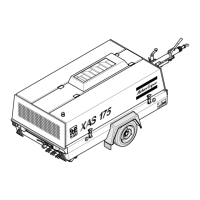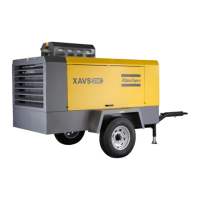- 39 -
Problem Solving
Problem Solving Chart
It is assumed that the engine is in good condition, there is
adequate fuel flow to the filter and injection equipment
and compressor/engine maintained with the recommended
oil.
Make sure that the wires are not damaged and that they are
clamped tight to their terminals.
For denomination of switches, relays, etc., see ELECTRIC
SYSTEM & see STARTING/STOPPING.
Alternator Precautions
1. Never reverse the polarity of the battery or the
alternator.
2. Never break any alternator or battery connections
while the engine is running.
3. When recharging the battery, disconnect it from the
alternator. Before using booster cables to start the
engine, be sure of the polarity and connect the batter-
ies positive to positive, negative to negative.
4. Never operate the engine without the main or voltage
sensing cables connected in the circuit.
An electrical fault must be traced by an
electrician.
Problem Possible faults Corrective actions
1. Lamps (H1, H2) do not light up when switching (S1)
to”l“ and applying lamp test.
a. Discharged or defective battery.
b. Loose battery cable(s) or oxidized terminals.
c. Loose connection or damaged wiring.
d. Contact switch (S1) defective.
e. Circuit breaker defective.
a.Check electrolyte level and charge battery. If no
cells are shorted and battery is discharged, trace
cause and correct.
b.Check and correct as necessary.
c.Check wiring and connections, correct as neces-
sary.
d.With (S1) switched in " I ", check voltage between
ground and respectively each of the terminals of (S1).
Voltage must register at each of the terminals; if not,
replace (S1).
e.Replace circuit breaker.
2. General alarm lamp (H2) does not light up when
switching (S1) to “1”; lamp (H1) lights up when
applying lamptest.
a.Lamp (H2) blown,
b.Alternator/regulator defective.
a.Replace lamp.
b.Disconnect the wire from alternator terminal D+
and connect it to terminal D-. If (H1) lights up,
replace the alternator; if not, test (S1); see remedy 1d.
3. Temperature alarm lamp (H1) does not light up when
switching (S1) to the “I“ position and applying lamp
test.
a.Lamp (H1) blown,
b.See fault 1d.
a.Replace lamp.
b.See 1d.
4. Starter motor does not crank engine after switching
(S1) to "I"
a.Low battery output.
b.Start button (S1) defective.
c.Alternator output inlay (K4) defective.
d.Start solenoid (KO) or starter motor defective
a.See remedy 1a.
b.With (S1) in position "I", check voltage between
earth and each of the terminals of (S1). Voltage must
register at each of the terminals; if not replace (S1).
c.Replace (K4).
d.Check start solenoid (K0). Have starter motor
repaired.

